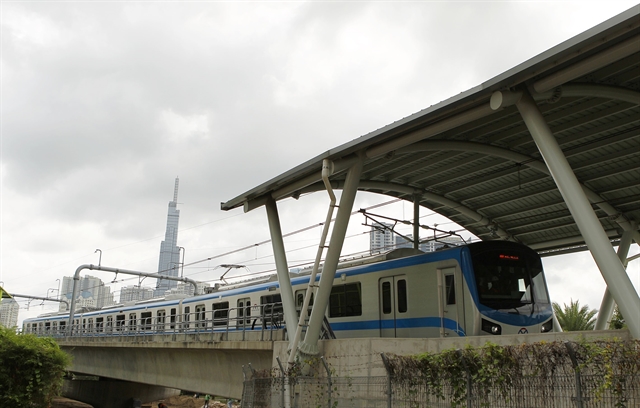 Society
Society


|
| A trial run of the Bến Thành-Suối Tiên metro line in HCM City in late August. — VNA/VNS Photo Thanh Vũ |
HÀ NỘI — The implementation of urban rail transit projects in the two biggest urban centres in the country, Hà Nội and HCM City, has been slow, and only 13km out of 583km planned has been put into operation, according to a report sent by the government to the National Assembly ahead of the parliamentary plenary sitting next week.
Minister of Transport Nguyễn Văn Thắng, on behalf of the Government and Prime Minister, signed the report on the implementation of the railway development policy and the use of state budget to invest in railway transport.
As per Hà Nội's planning, there will be 10 metro lines with a total length of 410km, while authorities will study the construction of connecting lines with satellite urban areas and plan some monorail lines to support the urban rail system.
In HCM City, eight cross-city and belt routes will be built to link the main centres of the city with a total length of about 173km; and three surface light rail or monorail lines.
However, these projects in both cities are way behind schedule. So far, only 13km of rail line has been put into operation, accounting for 10.4 per cent of the total planned investment length of the network before 2020.
Urban rail transport also has failed to meet the target of accounting for 15-20 per cent of public passenger transportation demand in both cities as per the plans.
The preparation and implementation of urban rail projects in Hà Nội and HCM City are both delayed, and suffering cost overruns.
Currently, the Government is directing the two cities to expedite the progress of investment and construction of projects according to the approved plans to meet transportation demand.
In Hà Nội, the Government has instructed the transport ministry to be the main investor in two metro lines, and the Hà Nội People's Committee to be investor of two lines.
So far, metro line 2A Cát Linh-Hà Đông in Hà Nội has been completed and put into operation in November 2021.
The technical design of metro line 1, Yên Viên-Ngọc Hồi, phase 1 has been done with ODA funding from Japan, and the railway network planning has been handed over to Hà Nội for further investment.
For metro line 3, Nhổn-Hà Nội Station, the elevated section from Nhổn to Cầu Giấy has been 'basically completed' and is expected to be put into operation by the end of 2023, while the section from Cầu GIấy to Hà Nội Station is under construction and expected to be put into operation in 2027.
Metro line 2, Nam Thăng Long - Trần Hưng Đạo, is being adjusted for the next phase of implementation.
In HCM City, the Government has instructed the city to invest in two metro lines. Currently, Line 1, Bến Thành-Suối Tiên, is under construction and expected to be completed in the fourth quarter this year.
Ground clearance is being done at line 2, Bến Thành-Tham Lương, to prepare for construction.
The report also reveals that the investment resources for urban rail projects in the two cities by 2023 will be over VNĐ71.5 trillion (about US$2.9 billion, at current exchange rates).
Specifically, Hà Nội will spend VNĐ39.6 trillion ($1.61 billion) for the implementation of four metro projects, and HCM City will allocate over VNĐ31.9 trillion ($1.3 billion) for the preparation and implementation of two metro projects.
North-South high-speed rail
The Government report also set 2050 as the completion time for the North-South high-speed rail line.
For this ambitious project, the transport ministry said it has set up an inter-agency working group to study the experiences of China, Spain, Japan, and Germany, which have developed high-speed railway systems, to update and improve the project report for the consideration by the Government and submission to the Politburo for review.
At the same time, a feasibility study report will be completed according to the opinions of the State Appraisal Council in 2023 and efforts will be made to approve the investment policy of the project in 2025.
To make the 2050 deadline, the Government requests the parliament to prioritise allocation of resources for the development of the railway sector in each phase of the medium-term plan.
In particular, separate investment resources should be allocated for the high-speed railway project on the North-South axis, and local resources should be mobilised to participate in the project investment. — VNS




